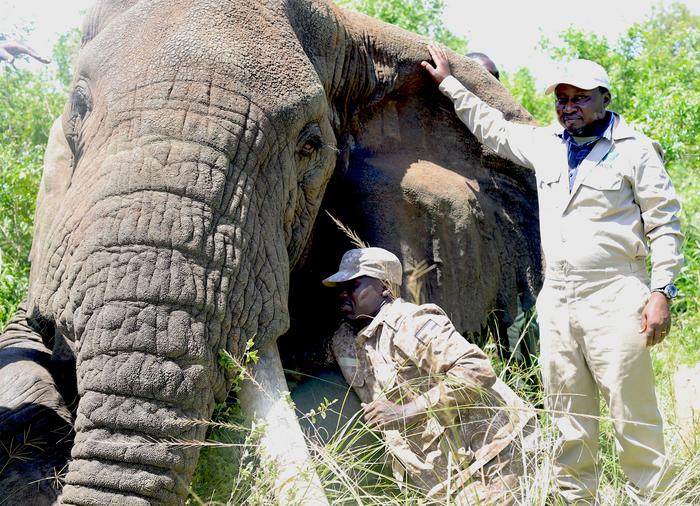January 31, 2024

Credit: Clinton Mwebaze/WCS
January 31, 2024
Climate Change Threatens Older Elephants Most, Jeopardizing African Elephants’ Future
New study from UMass Amherst and Wildlife Conservation Society finds that continuing international cooperation, community involvement most important in ensuring elephants’ survival
AMHERST, Mass. – A collaborative team of researchers from the University of Massachusetts Amherst and the Wildlife Conservation Society (WCS), which runs the world’s largest field conservation program, has conducted first-of-its kind research into how global climate change affects African elephants. The work, published recently in PLOS Sustainability and Transformation, shows that older elephants will have markedly decreased chances of survival, which will not only drastically reduce the species’ overall ability to weather the changing climate but will send ripple effects throughout the surrounding landscape. The team has also modelled possible mitigation scenarios, which WCS is already implementing.
Africa’s Greater Virunga Landscape (GVL) is a 15,700-square-kilometer area of savannas, mountains and lakes in Uganda, Rwanda and the Democratic Republic of Congo. It is home to the largest land animals in Africa, with seven national parks, three tropical high-forest reserves and three wildlife reserves, three of which are world heritage sites, covering 88% of the area. It is also home to a population of African elephants whose numbers have dropped so precipitously over the past century that they are now listed as critically endangered by the International Union for Conservation’s Red List.
Elephants play a key role in modifying and sustaining their landscapes by dispersing the seeds of the plants they feed upon, felling trees and enriching soil fertility with their dung. They also play an important role in many African cultures.
To date, few studies have focused on the dynamics of the environment, climate change, elephant demography and how the changing habitat influences elephants over long periods. To get a clearer picture of what the elephants’ future might look like and what we can do to best ensure their survival, lead author Simon Nampindo, who completed this research as part of his Ph.D. in environmental conservation for UMass Amherst and who is now country director for WCS Uganda, and Timothy Randhir, professor of environmental conservation at UMass Amherst, built a systems dynamic model. “This model,” says Nampindo, “can look at all the different environmental and population dynamics within a system. For the first time, we’re able to get a comprehensive vision of what the future might look like for African elephants in the face of climate change.”
Nampindo and Randhir built their model using data on the numbers of elephants, historical changes in the landscape and different future climate-change scenarios representing 1.6 º, 2.8º and 4.3º Celsius of warming over the next 80 years. Finally, they charted the effect each of the climate scenarios would have on five elephant age brackets: under 10 years old, 11 – 30, 31 – 40, 41 – 50, and more than 50 years old, because, as Randhir puts it “any impact on one age class has a community effect throughout the entire population.”
“We found that the older elephants will be massively affected by warming under every scenario,” says Nampindo. “Elephants are matriarchal—their leaders are the older cows, and the herds depend on their wisdom, long memories and ability to outsmart prey, and if they are lost to changing climate, it will wreak havoc on the surviving, younger herds, as well as change the genetic profiles and structures of the herd. There will also be ripple effects through the GVL’s landscape.”
“But,” says Randhir, “this model not only tells us what the threats are, we can also use it to tell us which policy possibilities will be most effective in helping African elephants to survive.”
In the case of a species like the elephant, which migrates widely across national boundaries, it is especially important to also understand how differing policies could affect future herds so that management agencies can coordinate their responses.
In particular, Nampindo and Randhir find that a coordinated GVL management strategy at the national, regional and local levels is needed to address poaching threats. Well-funded anti-poaching efforts are essential, but they also point to the importance of community-led programs and education in the front-line towns and villages where human-elephant interaction is common. The GVL landscape must also be managed appropriately to reduce the impact of habitat fragmentation, fire and invasive species.
“These results are very important to WCS,” says Nampindo. “If we can do a good job at protecting elephants, our efforts will reverberate to other species, such as lions and mountain gorillas.”
“More broadly,” says Randhir, “the most exciting thing about this systems dynamic modeling is that it can be adapted to any migratory species that move across political boundaries, from fish to birds to lions.”
A media kit, with photos, captions, credit info and a copy of the study is available here.
Contacts: Timothy Randhir (UMass Amherst), [email protected]
Daegan Miller (UMass Amherst), [email protected]
Mary Dixon (WCS), [email protected]
Journal
PLOS Sustainability and Transformation
DOI
10.1371/journal.pstr.0000094
Article Title
Dynamic modeling of African elephant populations under changing climate and habitat loss across the Greater Virunga Landscape
Article Publication Date
31-Jan-2024




